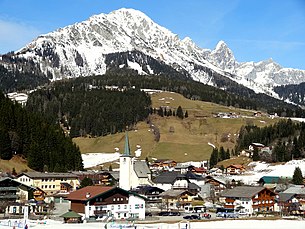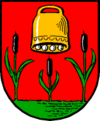Filzmoos (Salzburg)
|
Filzmoos
|
||
|---|---|---|
| coat of arms | Austria map | |
|
|
||
| Basic data | ||
| Country: | Austria | |
| State : | Salzburg | |
| Political District : | St. Johann im Pongau | |
| License plate : | JO | |
| Main town : | Filzmoos | |
| Surface: | 75.65 km² | |
| Coordinates : | 47 ° 26 ' N , 13 ° 31' E | |
| Height : | 1057 m above sea level A. | |
| Residents : | 1,513 (January 1, 2020) | |
| Postal code : | 5532 | |
| Area code : | 06453 | |
| Community code : | 5 04 07 | |
| Address of the municipal administration: |
Filzmoos No. 32 5532 Filzmoos |
|
| Website: | ||
| politics | ||
| Mayor : | Christian Mooslechner ( SPÖ ) | |
|
Municipal Council : (2019) (17 members) |
||
| Location of Filzmoos in the St. Johann im Pongau district | ||
 Filzmoos southwest of the Rötelstein |
||
| Source: Municipal data from Statistics Austria | ||
Filzmoos is a municipality with 1513 inhabitants (as of January 1, 2020) in the Salzburg region in the St. Johann im Pongau district in Austria . The community has shares in the UNESCO World Heritage Hallstatt – Dachstein / Salzkammergut .
geography
The municipality is located in the northeast of Pongau , at the foot of the Dachstein on the border with Upper Austria and Styria . The Dachstein summit itself does not belong to the municipality, the triangle is the Torstein ( 2948 m above sea level ).
The municipal area includes the upper valley of the Mandling and the Obere Fritz (Schattbachtal, valley of the Fritzbach). The former already flows towards the Enns , the latter towards the Salzach , between the two lies the Übermoos valley watershed .
The north of Filzmoos, the world heritage area with the Gosaukamm and the striking Bischofsmütze ( 2458 m above sea level ) belongs to the Dachstein massif of the Limestone Alps . The southern and western parts of the community on Rossbrand ( 1770 m above sea level ) and Gerzkopf ( 1728 m above sea level ) are among the Fritztal mountains of the Salzburg Slate Alps .
Community structure
The municipality includes the following two localities and cadastral communities (population in brackets as of January 1, 2020):
- Filzmoos (main town) - in the east on the Mandling (769)
- Neuberg - in the west in the Fritz (744)
The only counting area is Filzmoos .
The community belonged to the Radstadt judicial district until 2004 and has been part of the Sankt Johann im Pongau judicial district since January 1, 2005 .
Neighboring communities
| Annaberg-Lungötz ( District Hallein / Tennengau ) |
Gosau ( District Gmunden , Upper Austria ) |
|
| In Pongau |

|
Ramsau am Dachstein ( district Liezen , Styria ) |
| Radstadt |
history
The first settlers were probably the Tauriskians . The Romans came to the area around the birth of Christ. Towards the end of the 6th century Slavs penetrated into the Ennstal, which were later followed by Bavarians , coming from the Lammertal .
Filzmoos was first mentioned in a document in 1333 under the name In dem Viltmoos . The name - both felt and moss - comes from the once very mossy and swampy valley floor of the high valley at the foot of the Dachstein massif, when only shepherds populated the valley.
In the past, mining was also carried out in Filzmoos. Silver, copper and iron were mined in several places, above all on Rötelstein, Mandlingzug (Rossbrand) and Arzberg, but also arsenic, lead and zinc. The names of the mountains themselves, as well as house and terrain names, are a reminder of this.
Filzmoos - like most of the country's mining areas - suffered badly from the eviction of Salzburg Protestants in 1731/32. The loss of more than half of the population had to be coped with.
Formerly an alpine pasture and mining area, today the place is increasingly shaped by tourism.
coat of arms
The municipal coat of arms is as follows described :
- " Three natural moss cobs growing out of green soil in red on a wet ground, raised by a golden bell with four silver bobbins."
It symbolizes the wet ground around Filzmoos and the legend of the Filzmooser Kindl .
politics
The community council has a total of 17 members.
- With the municipal council and mayoral elections in Salzburg in 2004, the municipal council had the following distribution: 9 ÖVP, 3 SPÖ, and 1 FPÖ.
- With the municipal council and mayoral elections in Salzburg in 2009 , the municipal council had the following distribution: 9 ÖVP, 3 SPÖ, and 1 FPÖ.
- With the municipal council and mayoral elections in Salzburg in 2014 , the municipal council had the following distribution: 9 ÖVP, 2 SPÖ, and 2 FPÖ. (13 members)
- With the municipal council and mayoral elections in Salzburg 2019 , the municipal council has the following distribution: 9 ÖVP, 5 SPÖ, and 3 FPÖ.
- mayor
- 1991–2019 Johann Sulzberger (ÖVP)
- since 2019 Christian Mooslechner (SPÖ)
economy
Today Filzmoos is primarily a tourist destination.
Culture and sights
- Filzmoos parish and pilgrimage church : late Gothic, 15th century, the "Filzmooser Kindl" is venerated here.
- Legend of the Filzmooser Kindl : Two shepherds who camped in the area found where the original chapel, built in 1820, is today, a carved Jesus child standing on a tree stump. It raised its oath fingers and rang a little bell. This Jesukindl was brought by the shepherds to the deanery church in Altenmarkt , but it returned to its place in Filzmoos overnight. Since then, it has been enthroned in a halo above the altar in the Filzmoos parish church, and healing of the sick and salvation from distress are ascribed to it.
- Oberhof: The farm was first mentioned in a document in 1285. 1333 was yeoman "Alblinno at the court" as a farmer working (the freeholders were not free people but own people of the archbishop, who sat as peasants on the estates that did not belong to the archbishop, but his vassals, as the Goldegger or Frundsberger) . Around 1604 the farm belonged to the noble knight dynasty of the Antretter and the Hofer family were their serfs and were then able to buy their way out and the farm has therefore been owned by the Hofer-Hofer-Salchegger family since 1648. In 1936 the Salzburg state government granted hereditary court rights.
- Farm museum: is located in the Oberhof, one of the oldest buildings in Filzmoos, which is maintained by the owner and farmer Christian Salchegger with his wife Johanna. At the Oberhof there is a plaque of the German poet Agnes Miegel , whose maternal ancestors descended from the Oberhof ( emigration of Salzburg Protestants in 1732 ).
- Oberhofalm: the Oberhofalm in Filzmoos also belongs to the Oberhof , a well-known excursion destination in the Hofalm area at the foot of the Bischofsmütze, the Gosaustein and Torstein (Dachstein Mountains). The Oberhof is a fully intact farm.
- Unterhofalm: also the Unterhofalm in Filzmoos, is a well-known excursion destination in the Hofalm area at the foot of the Bischofsmütze, the Gosaustein and Torstein (Dachstein Mountains).
- International hot air balloon week in Filzmoos: has been held every year since 1979 at the beginning of January with international balloonist teams.
- Hubertus Festival: every two years in Filzmoos at the Hubertus Chapel, the Hubertus Festival is held by the Filzmoos hunters.
- Christmas idyll in the Hofalm
education
- kindergarten
- Elementary school
Sports
- The Filzmoos ski area is part of the Salzburger Sportwelt in the Ski amadé and has two ski mountains with a total of twelve kilometers of slopes, with a gondola lift, two chair lifts and five drag lifts: to the south on the Rossbrand , up to 1600 m , where there is also a high-altitude cross-country ski run. to the north on the Großberg ( 1380 m ). The Filzmooser Skiclub is currently represented in the World Cup by Michaela Kirchgasser and Philipp Schörghofer .
- With the USK Raika Filzmoos, the community also has a soccer team that plays in the 2nd class south. The club has been champion twice so far. 1993/94 and 2001/02
Personalities
- Sons and daughters of the church
- Barbara Passrugger (1910-2001), b. Hofer, writer
- Brigitte Totschnig (* 1954), former ski racer, sportswoman of the year, downhill world cup winner and Olympic runner-up
- Astrid Vierthaler (* 1982), former ski racer, junior world champion in 2001 downhill, Austrian state champion in 2003 downhill
- People related to the community
- Johanna Maier (* 1951), award-winning chef at the Hotel Hubertus in Filzmoos, the only Gault-Millau 3-toque chef
- Philipp Schörghofer (* 1983), ski racer, grew up in Filzmoos
- Michaela Kirchgasser (* 1985), ski racer, grew up in Filzmoos
literature
- George Turner: We'll take home with us: A contribution to the emigration of Salzburg Protestants in 1732, their settlement in East Prussia and their expulsion in 1944/45 using the example of the Hofer family from Filzmoos. Berliner Wissenschaftsverlag, 2014, ISBN 978-3-8305-3364-1 .
- Romana Wimmer: Macrozoobenthos in the Black Lacquer of Filzmoos (Salzburg). Bachelor thesis , University of Salzburg, 2009.
- Horst Weiß: Mountain tours around Filzmoos. Häusler, 2005, ISBN 3-933344-29-8 .
- Christian Salchegger: Filzmoos: Traditional and Experienced, 1333–1993. C. Salchegger senior, Filzmoos 1996
- Ernst Schrom in Filzmoos: a painter and his subject. (= Salzburg contributions to folklore. Volume 7). Salzburg State Institute for Folklore, Salzburg 1995, DNB 944281834 .
- Barbara Passrugger: Steep slope. (= So that it is not lost. Volume 27). Böhlau Verlag, Vienna 1993, ISBN 3-205-98040-9 .
- Structural profiles of the municipalities of the State of Salzburg, part: Filzmoos, municipality code 50407, Pol. Ident .: Sankt Johann im Pongau, Ger. Ident .: Radstadt. Salzburg Institute for Spatial Research, 1986.
- Alfred Webinger: Filzmoos - A little book to guide you through the southern Dachstein landscape. 2nd Edition. Self-published, Graz 1950.
- Martin Winkler: The Filzmoos dialect in Salzburg. Dissertation . University of Innsbruck, 1924.
Web links
Individual evidence
- 50407 - Filzmoos (Salzburg). Community data, Statistics Austria .
- ↑ Statistics Austria: Population on January 1st, 2020 by locality (area status on January 1st, 2020) , ( CSV )
- ^ Austrian art topography 28. The art monuments of the district of Bischofshofen. Baden near Vienna 1940, p. 82.
- ^ Johann Sulzberger . In: Salzburger Nachrichten : Salzburgwiki .
- ↑ Homepage of the parish and pilgrimage church Filzmoos
- ↑ Ski regions: Filzmoos - Salzburger Sportwelt . Ski amadé
- ↑ Ski regions: Filzmoos . bergfex.at - with a piste map











